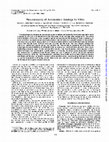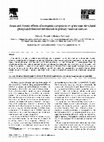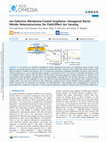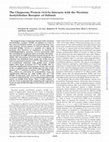Papers by Mark A DeCoster

Recent Progress in Materials
Green synthesis of nanomaterials endeavors to reduce the use of high energy methods with those th... more Green synthesis of nanomaterials endeavors to reduce the use of high energy methods with those that may include lower temperatures and pressures, use of natural products, and bottom-up self-assembly. Here we describe the generation of metal-organic biohybrids (MOBs) with nanoscale features synthesized at physiological (37°C) and room temperature (25°C). These MOBs utilized the naturally occurring amino acid dimer cystine as the biological component, and a series of metals, including copper, silver, and cobalt. The copper- and silver- based nanomaterials generated were distinct in size and shape. Copper formed elongated high-aspect ratio structures which we have named CuHARS. In contrast, the self-assembly of cystine and silver formed nanoparticles which we designate as AgCysNPs, and cobalt formed particles which we designate as CoMOBs. Both cobalt and silver could be combined with copper in the same reaction vessel to carry out green synthesis of different nanomaterials simultaneous...

Frontiers in Cellular Neuroscience, 2021
Glial cells play an important role in maintaining neuronal homeostasis and may thus influence exc... more Glial cells play an important role in maintaining neuronal homeostasis and may thus influence excitability in epileptogenesis. These cells in the brain have glutamate (Glu) transporters, which remove this neurotransmitter from the extracellular space. Lack of negative (−) feedback makes local neuronal circuits more excitable and potentially contributing to epileptogenic phenomena. In this study, the role of glial cells in providing (−) feedback is shown through different models of brain cells in culture imaged for intracellular calcium concentration [(Ca2+)i]. Moreover, here we study the individual cells by putting them in categories. Neuronal networks with high and low (−) feedback were established by using anti-mitotics to deplete glial cells. Separate stimuli with very low subthreshold concentrations of Glu (250–750 nM) were added to cultures to test if the order of stimulations matter in regard to calcium dynamics outcomes. Additionally, KCl and ATP were used to stimulate glial ...
The Society for Neuroscience Abstracts, 1990
NeuroReport, 1994
The effect of the neuroprotective K opioid agonist CI-977 on glutamate (GLU)-stimulated calcium s... more The effect of the neuroprotective K opioid agonist CI-977 on glutamate (GLU)-stimulated calcium signaling was studied in individual primary rat cortical neurons. Using laser scanning confocal microscopy and the fluorescent calcium probe fluo-3, both the sustained and biphasic intracellular calcium concentration [Ca2+]i changes induced by GLU (20–40 μUM) were altered by CI-977 (25–100 nM), thereby shifting the neuronal population response from unbuffered to buffered patterns of [Ca2+]i flux. This effect was consistent with the previously demonstrated neuroprotective action of CI-977 against glutamate toxicity in vitro. The effect of CI-977 in altering GLU-induced [Ca2+]i signaling was attenuated by naloxone, consistent with a neuroprotective action of CI-977 at opioid receptors, presumably of the k subtype.

Clinical Neuropharmacology, 1994
Epilepsy and CNS injury identify a heterogenous group of diseases, many of which exhibit refracto... more Epilepsy and CNS injury identify a heterogenous group of diseases, many of which exhibit refractoriness (e.g., the partial epilepsies) to established drug therapy or, as in the case of brain and spinal cord injuries of variable etiologies, remain a formidable target for successful drug development. As such, the search for safe, effective antiepileptic and neuroprotective drugs continues. Although several CNS targets have been identified for drug development, especially the excitatory amino acid receptors, free-radical systems, gangliosides, and nitric oxide, etc., the opioid system and its diversity of receptors have, until recently, received little attention. This review attempts to focus on one opioid system, namely the kappa receptor class of opioid ligands, specifically addressing the potential anticonvulsant and neuroprotective properties of the arylacetamide series of kappa opioid analgesics as novel pharmacotherapeutic approaches to the treatment of epilepsy, stroke, or trauma related brain or spinal cord injury.

Brain Research, 1995
The role of the putative ~r receptor in mediating neuroprotection against glutamate-iriduced neur... more The role of the putative ~r receptor in mediating neuroprotection against glutamate-iriduced neuronal injury was examined in mature cultured rat cortical neurons. With the exception of the selective ~1 ligand (+)-3-PPP, all of the ~r ligands tested were neuroprotective, preventing glutamate-induced morphological changes and increases in LDH release. Their rank order of neuroprotective potency (and ECs0 values) was as follows: (+)-SKF 10,047 (0.81 /~M)>(+)-cyclazocine (2.3 /xM)> dextromethorphan (3.1 p,M) = haloperidol (3.7 /zM) > (+)-pentazocine (8.5 /zM)> DTG (42.7 /xM)= carbetapentane (46.3 /zM). When corrected fe,r relative tr versus PCP binding affinity, it appears that a positive correlation exists between neuroprotective potency and tr I site affinity. However, there does not appear to be a significant correlation between neuroprotective potency and the tr 2 site. Critically, none of the ~ ligands were neurotoxic when tested alone at concentrations at least 5-30 times their respective neuroprotective ECs0 values. Results from preliminary experiments with the selective tr I ligand (+)-pentazocine indicated that tr-mediated neuroprotection may involve the buffering of glutamate-induced calcium flux. Collectively, the results of these in vitro experiments demonstrate that ~r ligands are neuroprotective and therefore deserve further exploration as potential therapeutic agents in in vivo models of CNS injury and neurodegenerative disorders.

Antimicrobial Agents and Chemotherapy, 1994
The sesquiterpene endoperoxide antimalarial agents arteether and artemether have been reported to... more The sesquiterpene endoperoxide antimalarial agents arteether and artemether have been reported to cause neurotoxicity with a discrete distribution in the brain stems of rats and dogs after multiple doses. The nature and distribution of the brain lesions suggest a specific neuronal target, the identity of which is unknown. In order to further investigate artemisinin analog-induced neurotoxicity, we evaluated several in vitro models: fetal rat primary neuronal cultures, fetal rat secondary astrocyte cultures, and transformed neuronal cultures (rat-derived neuroblastoma NG108-15 and mouse-derived neuroblastoma Neuro-2a). Results indicate that toxicity was specific for neuronal cell types but not glial cells. Neurotoxicity, as indexed by liberation of lactate dehydrogenase and/or inhibition of radiolabelled-leucine uptake, was seen in all three neuronal culture types, implicating a common target. In vitro neurotoxicity was dose and time dependent. Acute exposure to drug results in delay...

Abstract : A series of 3-substituted 17-methylmorphinan analogs of dextromethorphan (DM) have bee... more Abstract : A series of 3-substituted 17-methylmorphinan analogs of dextromethorphan (DM) have been developed which are anticonvulsant against maximal electroshock seizures in rats. These findings have been extended to a rat model of NMDA convulsions where it has been determined that the aniline (AHN649), O-ethylether (AHN1036) and 0-isopropylether (AHN1037) analogs are anticonvulsant. Recent assessments of neurologic impairment have shown that these DM analogs also display exceptional side-effect profiles, yielding protective indices several fold greater than those established for other standard anticonvulsant drugs. In in vitro and in vivo models of neuronal injury we have determined that AHN649 is at least equipotent to DM as a neuroprotectant. Finally, analysis of binding potencies has revealed no appreciable activity at the non-competitive PCP/MK801 site or the glycine modulatory site of the NMDA receptor complex. Alternatively, interactions with distinct high affinity DM binding sites in brain appear to be involved. We propose that these potent, safe analogs of DM may be of potential therapeutic utility as adjuncts in the treatment of agent-induced convulsions and neurotoxicity.

Journal of Biological Chemistry, 1999
Glutamate receptors modulate multiple signaling pathways, several of which involve mitogen-activa... more Glutamate receptors modulate multiple signaling pathways, several of which involve mitogen-activated protein (MAP) kinases, with subsequent physiological or pathological consequences. Here we report that stimulation of the N-methyl-D-aspartate (NMDA) receptor, using platelet-activating factor (PAF) as a messenger, activates MAP kinases, including c-Jun NH 2-terminal kinase, p38, and extracellular signal-regulated kinase, in primary cultures of hippocampal neurons. Activation of the metabotropic glutamate receptor (mGluR) blocks this NMDA-signaling through PAF and MAP kinases, and the resultant cell death. Recombinant PAF-acetylhydrolase degrades PAF generated by NMDA-receptor activation; the hetrazepine BN50730 (an intracellular PAF receptor antagonist) also inhibits both NMDA-stimulated MAP kinases and neuronal cell death. The finding that the NMDA receptor-PAF-MAP kinase signaling pathway is attenuated by mGluR activation highlights the exquisite interplay between glutamate receptors in the decision making process between neuronal survival and death. Glutamate receptors participate in neural development, plasticity, learning, memory, and pathology, (e.g. excitotoxicity and neurodegenerative diseases.) Overactivation of the glutamate ionotropic receptors leads to excitotoxic cell death. NMDA 1 receptor antagonism results in prominent neuroprotection in vivo and in vitro. The signals generated by these receptors activate the stress-sensitive MAP kinases JNK and p38 that are implicated in neuronal apoptosis (1). A role for JNK in the excitotoxic death of hippocampal neurons in vivo has been recently illustrated using JNK3 Ϫ/Ϫ mice (2). How
2016 32nd Southern Biomedical Engineering Conference (SBEC), 2016
Previous experiments have documented the discovery of novel high-aspect ratio structures (HARS) c... more Previous experiments have documented the discovery of novel high-aspect ratio structures (HARS) composed of cystine and copper synthesized in a physiological environment. These HARS scale in size from nano to micro dimensions and have favorable properties such as biocompatibility, long-term stability, and non-agglomerating properties. Here we tested for: optimal synthesis conditions, stability limits, and their application to uniformly coat films. Because the HARS have an amino acid component, functionalization using layer-by-layer techniques may provide strategies for improved imaging, masking, and ordering the structures for controlled interaction with cells in 2d and 3d spaces.

International Journal of Developmental Neuroscience, 1994
lt was the purpose of the present study to evaluate glutamate-stimulated phosphatidylinositol met... more lt was the purpose of the present study to evaluate glutamate-stimulated phosphatidylinositol metabolism in primary mixed astrocyte/neuron and neuron-enriched cortical cultures through different stages of development in vitro. Glutamate (0-200 ;,M) stimulated inositol phosphate accumulation in a concentration-dependent fashion at 6. 13 and 20 days in vitro. Pure astrocyte cultures exhibited glutamate-stimulated phosphatidylinositol hydrolysis only at high concentrations (100-400 ;iM), indicating that these cells contribute little to the overall inositol phosphate accumulation measured in mixed neuronal cultures treated with low glutamate concentrations. Comparison of mixed neuronal cultures with and without antimitotic treatment revealed that increasing astrocyte number suppressed glutamate-stimulated responses, presumably via glutamate uptake. In contrast to previous reports, glutamate-stimulated inositol phosphate accumulation, when expressed as a function of cell number, increased with increasing days in vitro.

Neuroscience Letters, 1996
Glutamate (Glu)-stimulated phosphatidylinositol (PI) metabolism in primary neuronal cultures was ... more Glutamate (Glu)-stimulated phosphatidylinositol (PI) metabolism in primary neuronal cultures was found to be modulated by acute and chronic treatment with two estrogenic compounds. 17fl-Estradiol 3-benzoate (0.1 and 1/zM), when applied with Glu, significantly reduced Glu (40/~M)-stimulated PI metabolism by 20-36%, an effect not seen with 17a-estradiol. The weak estrogen phenol red (20/~M), had no effect when added immediately before Glu stimulations. Two-week pretreatment with 17fl-estradiol 3-benzoate (1/~M) resulted in a significant decrease in Glu-stimulated PI metabolism (10-100/~M). Chronic treatment with 20/tM phenol red, at a concentration commonly found in culture medium, resulted in parallel but not statistically significant effects to those observed with chronic estradiol treatment. Estrogenic compounds may modulate the excitatory responses of neurons by both genomic and non-genomic means.

NeuroReport, 1992
Intracellular calcium concentration ([Ca2+]i) dynamics were simultaneously monitored in multiple ... more Intracellular calcium concentration ([Ca2+]i) dynamics were simultaneously monitored in multiple cultured rat neurons loaded with Fluo-3 and continuously stimulated with glutamate (GLU). Three response types were observed: 10 microM GLU caused an initial transient increase in [Ca2+]i; 20 microM a biphasic response characterized by a 150-350 s 'calcium trough' between peaks; and 40 microM an initial sustained increase in [Ca2+]i. Neurons in calcium-free medium treated with 40 microM GLU showed only an initial transient increase in [Ca2+]i, demonstrating the dependence of sustained secondary increases in [Ca2+]i on extracellular calcium sources. We observed synchronized responses of multiple neurons within a given culture well, after GLU treatment, supporting the hypothesis that sustained influx of extracellular calcium may be stimulated by depletion of intracellular calcium and/or the release of endogenous excitatory amino acids.

An intrinsic ion sensitivity exceeding the Nernst−Boltzmann limit and an sp 2-hybridized carbon s... more An intrinsic ion sensitivity exceeding the Nernst−Boltzmann limit and an sp 2-hybridized carbon structure make graphene a promising channel material for realizing ion-sensitive field-effect transistors with a stable solid−liquid interface under biased conditions in buffered salt solutions. Here, we examine the performance of graphene field-effect transistors coated with ionselective membranes as a tool to selectively detect changes in concentrations of Ca 2+ , K + , and Na + in individual salt solutions as well as in buffered Locke's solution. Both the shift in the Dirac point and transconductance could be measured as a function of ion concentration with repeatability exceeding 99.5% and reproducibility exceeding 98% over 60 days. However, an enhancement of selectivity, by about an order magnitude or more, was observed using transconductance as the indicator when compared to Dirac voltage, which is the only factor reported to date. Fabricating a hexagonal boron nitride multilayer between graphene and oxide further increased the ion sensitivity and selectivity of transconductance. These findings incite investigating ion sensitivity of transconductance in alternative architectures as well as urge the exploration of graphene transistor arrays for biomedical applications.
Journal of Computational Neuroscience, 2010
A three-dimensional model of the reactiondiffusion processes of a neurotransmitter and its ligand... more A three-dimensional model of the reactiondiffusion processes of a neurotransmitter and its ligand receptor in a disk shaped volume is proposed which represents the transmission process of acetylcholine in the synaptic cleft in the neuromuscular junction. The behavior of the reaction-diffusion system is described by a three-dimensional diffusion equation with nonlinear reaction terms due to the rate processes of acetylcholine with the receptor. A new stable and accurate numerical method is used to solve the equations with Neumann boundaries in cylindrical coordinates. The simulation analysis agrees with experimental measurements of end-plate current, and agrees well with the results of the conformational state

Journal of Biological Chemistry, 2001
By using the large cytoplasmic domain of the nicotinic acetylcholine receptor (AChR) ␣4 subunit a... more By using the large cytoplasmic domain of the nicotinic acetylcholine receptor (AChR) ␣4 subunit as a bait in the yeast two-hybrid system, we isolated the first cytosolic protein, 14-3-3, known to interact directly with neuronal AChRs. 14-3-3 is a member of a family of proteins that function as regulatory or chaperone/ scaffolding/adaptor proteins. 14-3-3 interacted with the recombinant ␣4 subunit alone in tsA 201 cells following activation of cAMP-dependent protein kinase by forskolin. The interaction of 14-3-3 with recombinant ␣4 subunits was abolished when serine 441 of the ␣4 subunit was mutated to alanine (␣4 S441A). The surface levels of recombinant wild-type ␣42 AChRs were ϳ2-fold higher than those of mutant ␣4 S441A 2 AChRs. The interaction significantly increased the steady state levels of the ␣4 subunit and ␣42 AChRs but not that of the mutant ␣4 S441A subunit or mutant ␣4 S441A 2 AChRs. The EC 50 values for activation by acetylcholine were not significantly different for ␣42 AChRs and ␣4 S441A 2 AChRs coexpressed with 14-3-3 in oocytes following treatment with forskolin. 14-3-3 coimmunopurified with native ␣4 AChRs from brain. These results support a role for 14-3-3 in dynamically regulating the expression levels of ␣42 AChRs through its interaction with the ␣4 subunit.








Uploads
Papers by Mark A DeCoster